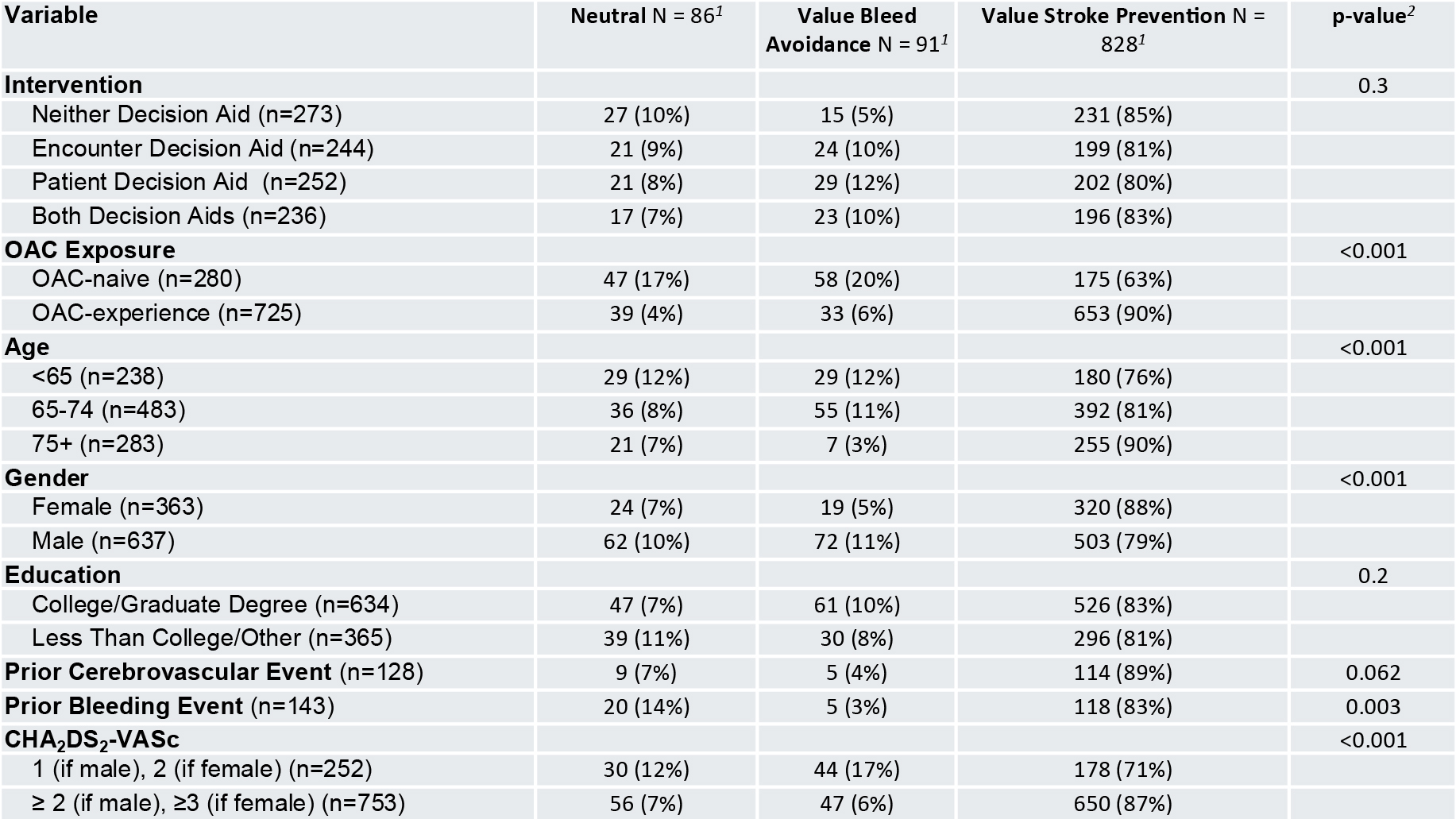Final ID: P1019
Patient Values and Anticoagulant Decisions in Atrial Fibrillation: a Secondary Analysis of the RED-AF Shared Decision-Making Trial
Abstract Body: Background: Deciding to use oral anticoagulation (OAC) for stroke prevention in patients with atrial fibrillation (AF) is complex. For many, the decision between treatment and non-treatment requires a primary tradeoff between the risks of potential stroke and increased bleeding.
Hypothesis: We hypothesized that patient values and empiric stroke risk measured by CHA2DS2-VASc score would influence OAC decisions.
Methods: We conducted a secondary analysis of a randomized clinical trial where eligible clinicians and patients were independently randomized to one of two decision aids (DAs) – a patient decision aid and/or an encounter decision aid. Eligible patients were adults with AF with CHA2DS2-VASc≥1 for men or ≥2 for women. Patients newly prescribed (OAC-naive subgroup) or already taking OAC (OAC-experienced subgroup) were included. We assessed patient values using a 5-point Likert scale between stroke prevention and bleeding risk after SDM during a clinical encounter.
We report preliminary results using descriptive statistics and adjusted analysis to investigate the effects of CHA2DS2-VASc and expressed values on OAC use.
Results: 1005 patients were included in the analysis. 828 (82%) patients valued stroke prevention over bleeding risk. Among the OAC-naive group, 175 (63%) valued stroke prevention more than bleed avoidance, 58 (20%) valued bleed avoidance more than stroke prevention, and 47 (17%) were neutral. In the unadjusted analysis, patients were more likely to value stroke prevention if they were OAC-experienced (p<0.001), older (p<0.001), female (p< 0.001), had patient-reported bleeding (p=0.003), or if CHA2DS2-VASc ≥ 2 if male, ≥3 if female (p<0.001) Table 1.
After adjustments, there were significant associations for OAC use among patients who valued stroke prevention (OR 5.35, 95%CI 3.13-9.13, p<0.001) or had higher CHA2DS2-VASc (OR 2.03, 95%CI 1.26-3.27, p=0.004). Patients who valued bleed avoidance had an opposing association not to use OAC (OR 0.23, 95%CI 0.11-0.48, p<0.001).
Conclusions:
Patients with elevated risk (CHA2DS2-VASc score, age, and female), and those who reported a prior bleeding event valued stroke prevention more than bleeding avoidance. Both empiric stroke risk and patient values were associated with the decision to use OAC. While the tradeoff between stroke prevention and bleeding risk is only one aspect of the decision-making process, these results indicate variability in patient values may influence OAC use.
Hypothesis: We hypothesized that patient values and empiric stroke risk measured by CHA2DS2-VASc score would influence OAC decisions.
Methods: We conducted a secondary analysis of a randomized clinical trial where eligible clinicians and patients were independently randomized to one of two decision aids (DAs) – a patient decision aid and/or an encounter decision aid. Eligible patients were adults with AF with CHA2DS2-VASc≥1 for men or ≥2 for women. Patients newly prescribed (OAC-naive subgroup) or already taking OAC (OAC-experienced subgroup) were included. We assessed patient values using a 5-point Likert scale between stroke prevention and bleeding risk after SDM during a clinical encounter.
We report preliminary results using descriptive statistics and adjusted analysis to investigate the effects of CHA2DS2-VASc and expressed values on OAC use.
Results: 1005 patients were included in the analysis. 828 (82%) patients valued stroke prevention over bleeding risk. Among the OAC-naive group, 175 (63%) valued stroke prevention more than bleed avoidance, 58 (20%) valued bleed avoidance more than stroke prevention, and 47 (17%) were neutral. In the unadjusted analysis, patients were more likely to value stroke prevention if they were OAC-experienced (p<0.001), older (p<0.001), female (p< 0.001), had patient-reported bleeding (p=0.003), or if CHA2DS2-VASc ≥ 2 if male, ≥3 if female (p<0.001) Table 1.
After adjustments, there were significant associations for OAC use among patients who valued stroke prevention (OR 5.35, 95%CI 3.13-9.13, p<0.001) or had higher CHA2DS2-VASc (OR 2.03, 95%CI 1.26-3.27, p=0.004). Patients who valued bleed avoidance had an opposing association not to use OAC (OR 0.23, 95%CI 0.11-0.48, p<0.001).
Conclusions:
Patients with elevated risk (CHA2DS2-VASc score, age, and female), and those who reported a prior bleeding event valued stroke prevention more than bleeding avoidance. Both empiric stroke risk and patient values were associated with the decision to use OAC. While the tradeoff between stroke prevention and bleeding risk is only one aspect of the decision-making process, these results indicate variability in patient values may influence OAC use.
More abstracts on this topic:
Abl1 kinase-deficient mouse hearts exhibit conduction disturbance and arrhythmia vulnerability to oxidative stress that are typically associated with age-related proarrhythmic remodeling
Choi Bum-rak, Bronk Peter, Li Xiaofei, Song Yi, Kim Tae Yun, Lu Yichun, Radice Glenn
A Hidden Threat: Trazodone-Induced Warfarin Failure Leading to Acute Mechanical Aortic Valve ThrombosisVogt Cody, Malik Saad, Pfirman Kristopher

